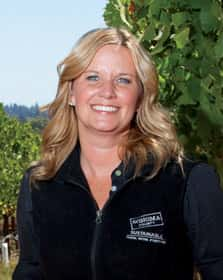 Will it rain? It’s going to be another hot one. The fog hung around all day. Most years, weather concerns take center stage as the winegrape harvest nears. However, this harvest season, a new focus of attention has dominated the tailgate chats and vine row walks—labor.
Will it rain? It’s going to be another hot one. The fog hung around all day. Most years, weather concerns take center stage as the winegrape harvest nears. However, this harvest season, a new focus of attention has dominated the tailgate chats and vine row walks—labor.
Why? There are a number of factors: a lack of immigration reform at the federal level, competition from other industries and an aging workforce. Perhaps more importantly, farming vineyards takes a skilled workforce, compared to many other crops. Pruning, crop thinning, leafing and harvest can impact the quality and quantity of the harvest. It takes an experienced and skilled workforce to raise the world-class grapes that are the backbone of Sonoma County wine.
What’s the real shortage? This past spring, Sonoma County Winegrowers conducted a survey of local grape growers. There were more than 295 respondents who represented more than 82 percent of the total vineyard acreage in Sonoma County, or some 47,975 acres planted to winegrapes. In this survey, grape growers stated that they currently employ 5,186 full-time workers and an additional 2,644 seasonal workers. Vineyard employees in Sonoma County earn on average $16.34 per hour, which is 60 percent above California’s current minimum wage of $10.50 per hour. However, almost 33 percent of grape growers don’t feel they have enough employees. The Sonoma County Winegrowers estimates the employee need to be 6,000 full-time employees and 4,000 part-time employees for peak times during the year.
In the face of a shrinking workforce, grape growers are doing what farmers do best—being resilient, flexible and proactive. As a result, they’re identifying and embracing new pieces of the farming puzzle to ensure the 2017 grape harvest is picked and meets Sonoma County’s world-class standard. Here are three key steps they’re taking. First, many grape growers proactively hired more full-time workers in the off-season, creating work opportunities for them to be employed year-round rather than scrambling for new employees during key times of pruning, thinning and harvest.
Second, some grape growers are shifting their reliance to the federal H-2A program, which allows agriculture employees to temporarily hire foreign guest workers for up to 10 months. However, the biggest challenge with this program is that it requires housing, and affordable housing in Sonoma County, may be a bigger current crisis than labor. It’s estimated that there are almost 300 H-2A ag employees working in Sonoma County this harvest season. H-2A is an option that grape growers, especially vineyard managers who farm approximately 40 percent of the county’s 58,235 vineyard acres in the county (which account for only 6 percent of Sonoma County’s one million acres) are strongly considering or forced to explore as a viable workforce option. However, to do this, grape growers will have to expand on the already 950-plus beds that they offer ag employees and their families locally. While grape growers have made developing workforce housing on their ag-zoned land a top priority there will not be enough housing to satisfy demand for the foreseeable future.
And finally, grape growers and winemakers are collaborating more than usual. Two specific areas of collaboration are the transition to mechanical harvesting where vineyards are able to support it and working together to be flexible (and patient) when possible on timing for different farming practices. Fortunately, the quality of mechanization has increased dramatically over the past five to 10 years, with many winemakers preferring the clean fruit that arrives at the winery when mechanically harvested. However, with 40 percent of the vineyards less than 20 acres in Sonoma County and the hillside spots famed for premium fruit, not every site is suitable for mechanization. With regard to timing, strong grape grower/winemaker relationships have been the foundation for elevating Sonoma County wines and the region over the last three decades. Negotiating reasonable compromises that allow the farmers to get the work done and still deliver the premium grapes are the benchmark of Sonoma County.
Mother Nature will always rule a farmer’s business, but labor is the hot topic of harvest 2017. For many of our local grape growers that means more time spent running operations and logistics in the office than getting their boots dirty in the vine row. However, when the harvest season comes to a glorious close in late October and early November, Sonoma County grape growers will deliver another outstanding grape harvest supporting Sonoma County’s world-class wine region. And these amazing, resilient, adaptable, intelligent men and women can take a brief breath as we gear up, once again, for the challenges of the next harvest season. Farmers are farmers and they would have it no other way.
Karissa Kruse is president of Sonoma County Winegrowers, a marketing and educational organization dedicated to the promotion and preservation of Sonoma County as one of the world’s premier grape growing regions. For more information, go to www.sonomawinegrape.com.



